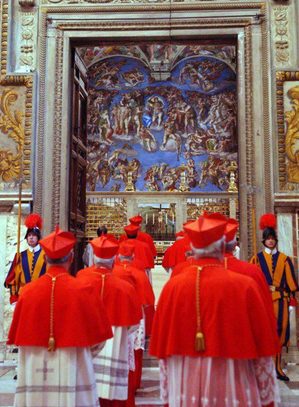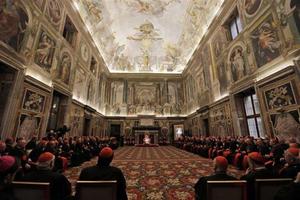Tag: Holy See
Papal apartments, Lateran Basilica sealed
 At 8pm Rome time on 28 February 2013, the Chair of Saint Peter went empty. The period of time is called sede vacante, the empty see; that is, the Holy Roman Church has no visible head on earth. There is no pope.
At 8pm Rome time on 28 February 2013, the Chair of Saint Peter went empty. The period of time is called sede vacante, the empty see; that is, the Holy Roman Church has no visible head on earth. There is no pope.
Details on Pope Benedict…
According to the Vatican Information Service, quoting the Holy See spokesman, Jesuit Father Frederico Lombardi, in a press conference, made some details public today regarding His Holiness. In sum, he said that Pope Benedict XVI:
- will be referred to as “Pope Emeritus” or “Pontiff Emeritus”;
- will keep the style “His Holiness, Benedict XVI”;
- will keep wearing a simple white cassock without the papal mozzetta; and
- that the fisherman’s ring, and the lead seal, will be broken.
Benedict is scheduled to arrive in Castel Gandolfo on 28 February, at 5:15pm -Rome time. At 8pm, Rome time), when the See of Peter goes vacant, the Swiss Guard will quietly leave the papal summer residence; the Guard’s services of protection are limited to the person of the Pontiff; the security of the “Pope Emeritus” will be assured by the Vatican Gendarmerie.
As commentary, some opined that the papal ring could be given to the Vatican Museum but the decision was made to continue to break the break to show the end of this papal reign. Perhaps the broken ring will be given to the Museum if it is not crushed beyond recognition.
It seems to me that in Benedict’s case, he ought to be readmitted to the College of Cardinals, be known as His Eminence, Joseph Cardinal Ratzinger, Bishop-emeritus of Rome. Moreover, he ought to adopt the clothes of a cardinal and be given the titular church of Sant’Anselmo or Santa Maria in Trastevere. I’d like him to be given the Benedictine Church of Sant’Anselmo!
In 1936, the King of England, Edward VIII, abdicated, he was first known as HRH Prince Edward, and then, HRH the Duke of Windsor.
Recently, Her Majesty Queen Beatrix of the Netherlands announced that she was abdicating throne on 30 April. Thereafter Beatrix will be known as Her Royal Highness, Princess Beatrix. You can only have on monarch at a time.
Roma locuta, causa finita.
Cardinal electors by region
Liturgical notes for the papal transition
The United States Conference of Catholic Bishops (USCCB) under the direction of Monsignor Richard Hilgartner of the Secretariat for Divine Worship, has produced a packet of materials regarding the pope.
OUR sede vacante … the key players… in the papal election
- The Apostolic Penitentiary Manuel Cardinal Monteiro de Castro, 74, does not cease working like many of the other offices of the Holy See and Vatican because the work of the Penitentiary pertains to the forgiveness of sins and matters of questions of conscience from the faithful. Sins and justice need to be forgiven. De Castro and his coworkers will remain in office.
- The Chamberlain (the Camerlengo), Tarcisio Cardinal Bertone, SDB, 78, who is the current Secretary of State, will see to the management of the temporal goods of the Church. Bills need to be made and leadership provided. He functions in this capacity during the sede vacante. Moreover, he will also head the Congregational meetings, that is, the daily meetings of the College of Cardinals discussing the needs of the Church. The cardinals will hear a “state of the Church.” During the conclave, Bertone will announce the result of every ballot, ascertaining the votes required for election. Cardinal Bertone will show the new pope to the papal apartments and hand him the keys. The Chamberlain will be assisted by Bishop Giuseppe Sciacca , 57, from Catania, who functions as a legal consultant.
Continue reading OUR sede vacante … the key players… in the papal election
The Cardinal electors for 2013
The list of cardinal-electors as of today is 118.
According to the Law of the Church, at the time that the Chair of Peter becomes vacant, those cardinals who achieve 80 years may not vote in the conclave. Pope Benedict said today that the Church is sede vacante at 8pm (Rome time) on 28 February. Therefore, Lubomyr Cardinal Husar born on 26 February 1933 becomes unable to vote in the 2013 conclave.
But observers will note that there are three cardinals who will be 80 around the time of the next conclave, a date still to be announced by Tarcisio Cardinal Bertone, Cardinal Secretary of State and the Carmerlengo.
They are:
Walter Cardinal Kasper: 5 March 1933
Severino Cardinal Poletto: 18 March 1933
Juan Cardinal Sandoval: 28 March 1933
In 2005, there were 117 cardinals (but only 115 participated in the papal election).
The oldest cardinal walking into the conclave will be Godfried Cardinal Daneels (4 June 1933), the emeritus archbishop of Mechelen-Brussel, Belgium.
The youngest cardinal will be Baselios Cleemis Cardinal Thottunkal (15 June 1959), Major Archbishop of Trivandrum, India.
The Americans in the Conclave:
Roger Cardinal Mahoney, 77
Francis Cardinal George, 76
Justin Cardinal Rigali, 77
William Cardinal Levada, 76
Sean Cardinal O’Malley, 68
Daniel Cardinal DiNardo, 63
Raymond Cardinal Burke, 64
Donald Cardinal Wuerl, 72
Timothy Cardinal Dolan, 63
Edwin Cardinal O’Brien, 73
James Cardinal Harvey, 63
Curbing sex abuse is a long term process
 Father Robert W. Oliver, a priest from Boston began his new work –a ministry of justice– as the new Promoter of Justice at the Congregation for the Doctrine of the Faith on February 1.
Father Robert W. Oliver, a priest from Boston began his new work –a ministry of justice– as the new Promoter of Justice at the Congregation for the Doctrine of the Faith on February 1.
Moses B. Anderson, SSE, dead at 84
 The Most Reverend Moses Bosco Anderson, SSE, 84, died on January 1, 2013, in Detroit.
The Most Reverend Moses Bosco Anderson, SSE, 84, died on January 1, 2013, in Detroit.
In a fractured world is Pope Benedict calling for political engagement?
Pope Benedict
gave his annual address, a “State of the Church,” if you will, to the curial officials
of the Holy See today.
You might say the content talk is crucially relevant for the
work of the Church and the proclamation of the Gospel as he reviews key events
and focuses on some themes. Among many things which need our attention and reflection,
the Pope spoke about nature of man, family life, and inter-religious dialogue.
Regarding man in which he gave insight into, he speaks of how evil and destructive vague and
ideological the “gender conscious crowd” is to the nature of the person and removes God from conversation. Read the full text here.
The Pope notes the crisis of the family and its effect on society, caused by the
unwillingness to make a commitment and by unwillingness to suffer. But he
goes beyond the symptoms to diagnose the cause of the crisis. This talk is not an attack, it is an appeal to truth.
Each of Pope
Benedict’s addresses to the Roman Curia are important, certainly the 2005
address stands out, but today’s will be memorable.
Here’s a section:
First of
all there is the question of the human capacity to make a commitment or to
avoid commitment. Can one bind oneself for a lifetime? Does this correspond to
man’s nature? Does it not contradict his freedom and the scope of his
self-realization? Does man become himself by living for himself alone and only
entering into relationships with others when he can break them off again at any
time? Is lifelong commitment antithetical to freedom? Is commitment also worth
suffering for? Man’s refusal to make any commitment – which is becoming
increasingly widespread as a result of a false understanding of freedom and
self-realization as well as the desire to escape suffering – means that man
remains closed in on himself and keeps his ‘I’ ultimately for himself, without
really rising above it. Yet only in self-giving does man find himself, and only
by opening himself to the other, to others, to children, to the family, only by
letting himself be changed through suffering, does he discover the breadth of
his humanity. When such commitment is repudiated, the key figures of human
existence likewise vanish: father, mother, child – essential elements of the
experience of being human are lost”.
Continue reading In a fractured world is Pope Benedict calling for political engagement?









